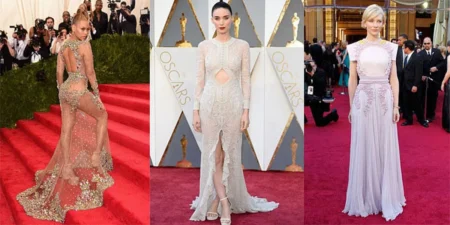London’s Fashion and Textile Museum is currently hosting Costume Couture, a new exhibition honoring 60 years of period costume design in film and television. The exhibition showcases the craftsmanship and historical accuracy of film period costumes created by Cosprop, one of the world’s most respected costume houses.
Founded in 1965 by designer John Bright, Cosprop aimed to bring a new level of realism to screen clothing. “If we made the stock as real as possible, it would be universal,” Bright says. “The truth is the truth for all times.”
Over the decades, Cosprop’s work has become legendary. Fans may instantly recall Colin Firth’s wet Regency-era shirt in 1995’s Pride and Prejudice, Meryl Streep’s safari gear in Out of Africa (1985), or Johnny Depp’s dishevelled 1720s outfit in Pirates of the Caribbean. Each piece involved meticulous research, period-accurate materials, and expert craftsmanship to achieve cinematic realism.
The exhibition includes many Oscar-winning costume designs. Highlights include outfits from A Room With a View (1985), Howards End (1992), and Little Women (2019). Visitors can also see Maxine Audley’s Miss Havisham wedding dress from BBC’s Great Expectations alongside Helen Cherry’s 1850s dress from The Charge of the Light Brigade.
Curator Keith Lodwick notes that Cosprop’s designs allow actors to fully transform. “Cosprop anchors itself in clothing that is accurate to the time and place,” he says. “That is why something like A Room With a View, made 40 years ago, still looks authentic today.”
The exhibition also spans multiple generations of Cosprop artisans. Younger employees often recall the 1990s series The House of Eliott, while long-time staff remember A Room With a View as their formative project. This breadth highlights the ongoing influence of Cosprop’s work on costume design careers.
A defining feature of Cosprop’s philosophy is authenticity. Unlike contemporary stylized productions such as Bridgerton, Cosprop focuses on clothing true to its historical period. Bright emphasizes that even costumes made for minor background roles, such as a tiered 1860s dress from Netflix’s The Leopard (2025), are created with the same dedication to realism.
Many of the techniques Cosprop employs are rare today, preserved only in couture fashion houses like Chanel or Dior. Hand-beading, period tailoring, and millinery work ensure each garment faithfully reflects its era. “The past is always what we build the future on,” Bright explains. “It’s good to have a string that takes us from the past to the future.”
Cosprop plays a vital role in preserving traditional skills. From alterations to millinery, many techniques have largely disappeared from modern production. Lodwick observes, “No matter what project is presented to them, Cosprop applies period-accurate methods, whether it’s Elizabeth, Game of Thrones, or Peaky Blinders.”
The historical accuracy also allows garments to look authentically aged without being old. Cosprop designers study archival clothing closely, replicating structures and fabrics so realistically that it can be hard to distinguish between original and recreated pieces.
Even as period dramas wax and wane in popularity, demand for Cosprop’s expertise remains steady. Lodwick says, “There can be a backlash to costume dramas, but new adaptations of Pride and Prejudice, Sense and Sensibility, and The Age of Innocence are in production. In turbulent times, these dramas transport audiences to a world that feels more stable and beautiful.”
Costume Couture highlights both the artistry and historical precision behind Cosprop’s creations. The exhibition celebrates decades of dedication to film period costumes, showing how carefully crafted clothing can make history come alive on screen.







